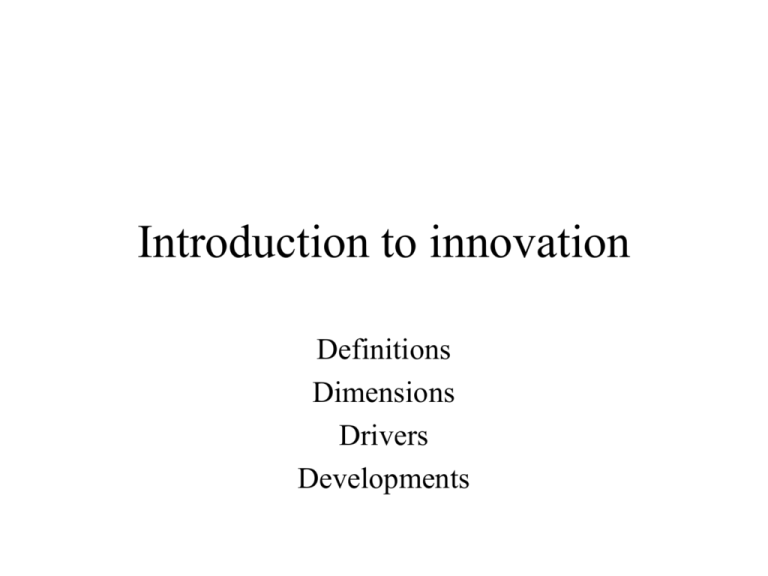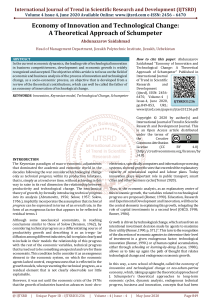Intro to innovation
advertisement

Introduction to innovation Definitions Dimensions Drivers Developments What is innovation? • Innovation is the process and outcome of creating something new, which is also of value. • Innovation involves the whole process from opportunity identification, ideation or invention to development, prototyping, production marketing and sales, while entrepreneurship only needs to involve commercialization (Schumpeter). What is innovation? • Today it is said to involve the capacity to quickly adapt by adopting new innovations (products, processes, strategies, organization, etc) • Also, traditionally the focus has been on new products or processes, but recently new business models have come into focus, i.e. the way a firm delivers value and secures profits. What is innovation? • Schumpeter argued that innovation comes about through new combinations made by an entrepreneur, resulting in – – – – – a new product, a new process, opening of new market, new way of organizing the business new sources of supply Dimensions of innovation There are several types of innovation – Process, product/service, strategy, which can vary in degree of newness: – Incremental to radical, and impact: continuous to discontinuous Drivers for innovation – Financial pressures to reduce costs, increase efficiency, do more with less, etc – Increased competition – Shorter product life cycles – Value migration – Stricter regulation – Industry and community needs for sustainable development – Increased demend for accountability – Demographic, social and maket changes – Rising customer expectations regarding service and quality – Changing economy – Greater availability of potentially useful technologies coupled with a need to exceed the competition in these technologies What is innovation? • Gary Hamel argued that today’s market place is hostile to incumbents, who now needs to conduct radical business innovation: – Radically reconceiving products and services, not just developing new products and services – Redefining market space – Redrawing industry boundaries New conditions for innovation • Small start-up entrepreneurs increasingly depend on large firms: – – – – – as suppliers or customers for venture finance, for exit opportunites, for knowledge (production, markets and R&D) and for opening new markets. New conditions for innovation • Large firms increasingly depend on small start-ups – for NPD, – as suppliers of new knowledge (which they cannot develop themselves), – or organizational renewal, for experimentation with busienss models, – for opening new markets, etc New developments in innovation raises new issues and problems • Greater emphasis on commercializing scientific discoveries, particularly in IT and the bio-sciences • Speed and potential value of scientific progress leads to emphasis on solid and well-designed portfolios of research projects • Universites as active drivers of innovation: Academic entrepreneurship and the entrepreneurial university • University-industry partnerships • Increased search for radical innovation and top-line growth.











